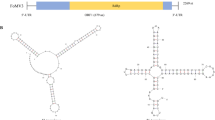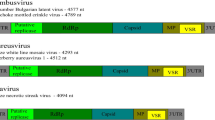Abstract
Two new umbravirus-like associated RNAs (ulaRNAs) were found, respectively, in maize and Johnsongrass samples from Ecuador. The complete sequences consist of 3,053 and 3,025 nucleotides, respectively, and contain four open reading frames (ORFs). Their genome sequences were 58% identical to each other and 28 to 60% identical to the most closely related viruses. Phylogenetic analysis using full genome sequences and amino acid sequence of the RNA-dependent-RNA polymerase (RdRp) placed both sequences in a clade sharing the most recent common ancestor with ulaRNAs from sugarcane and maize, suggesting that they belong to a monophyletic grass-infecting lineage. Their terminal regions exhibit features common to umbraviruses and ulaRNAs.


Similar content being viewed by others
Data availability
The genomic sequences of the two viruses reported here have been deposited in the GenBank database under the accession numbers OM937759 and OM937760.
References
Villamor DEV et al (2019) High throughput sequencing for plant virus detection and discovery. Phytopathology 109(5):716
Minicka J et al (2020) High-throughput sequencing facilitates discovery of new plant viruses in Poland. Plants 9(7):820
Simmonds P et al (2017) Virus taxonomy in the age of metagenomics. Nat Rev Microbiol 15(3):161–168
Lommel SA, Sit TL (2008) Tombusviruses. In: Mahy BWJ, Van Regenmortel MHV (eds) Encyclopedia of virology, 3rd edn. Academic Press, Oxford, pp 145–151
Ryabov EV, Taliansky ME (2020) Umbraviruses (Calvusvirinae, Tombusviridae). Reference module in life sciences. Elsevier, Amsterdam
Tahir MN et al. (2021) A new virus of the family Tombusviridae infecting sugarcane. Arch Virol. 166(3):961–965. https://doi.org/10.1007/s00705-020-04908-9
Cornejo-Franco JF et al (2021) An umbra-related virus found in babaco (Vasconcellea × heilbornii). Arch Virol 166(8):2321–2324
Wang X et al (2021) Genome characterization of fig umbra-like virus. Virus Genes 57(6):566–570
Koloniuk I et al (2022) Identification and characterization of a novel umbra-like virus, strawberry virus A, infecting strawberry plants. Plants 11(5):643
Kwon S-J et al (2021) Complete nucleotide sequence, genome organization, and comparative genomic analyses of citrus yellow-vein associated virus (CYVaV). Front Microbiol 12:1371
Felker PBR, Russo G, Preston K, Tine JA, Suter B, Xiao-han M, Cushman JC, Yim WC (2019) Biology and chemistry of an Umbravirus like 2989 bp single stranded RNA as a possible causal agent for Opuntia stunting disease (engrosamiento de cladodios)—a review. J Prof Assoc Cactus Dev 21:31
Liu J et al (2021) Structural analysis and whole genome mapping of a new type of plant virus subviral RNA: Umbravirus-like associated RNAs. Viruses 13(4):646
Quito-Avila DF et al (2015) Detection and partial genome sequence of a new umbra-like virus of papaya discovered in Ecuador. Eur J Plant Pathol 143(1):199–204
Cornejo-Franco JF et al (2020) Exploring the virome of Vasconcellea x heilbornii: the first step towards a sustainable production program for babaco in Ecuador. Eur J Plant Pathol 157(4):961–968
Sá Antunes TF et al (2016) The dsRNA virus Papaya Meleira virus and an ssRNA virus are associated with papaya sticky disease. PLoS ONE 11(5):e0155240
Zamudio-Moreno E et al (2015) Early diagnosis of a Mexican variant of Papaya meleira virus (PMeV-Mx) by RT-PCR. Genet Mol Res 14(1):1145–1154
Campbell P (2018) New test to offer early detection of papaya sticky disease. Papaya press, p. 1. https://australianpapaya.com.au/website/wp-content/uploads/2018/05/PAPAYAPRESS-MAY.pdf(1)
Redila CD, Prakash V, Nouri S (2021) Metagenomics analysis of the wheat virome identifies novel plant and fungal-associated viral sequences. Viruses 13(12):2457. https://doi.org/10.3390/v13122457
Kumar S et al (2018) MEGA X: molecular evolutionary genetics analysis across computing platforms. Mol Biol Evol 35(6):1547–1549
Liu J, Simon AE (2022) Identification of Novel 5' and 3' translation enhancers in Umbravirus-like coat protein-deficient RNA replicons. J Virol 96(7):e0173621. https://doi.org/10.1128/jvi.01736-21.
Simon AE (2015) 3′UTRs of carmoviruses. Virus Res 206:27–36
Simon AE, Miller WA (2013) 3’ cap-independent translation enhancers of plant viruses. Annu Rev Microbiol 67:21–42
McCormack JC et al (2008) Structural domains within the 3’ untranslated region of Turnip crinkle virus. J Virol 82(17):8706–8720
Acknowledgements
The contribution of Viola Weichelt and Dennis Knierim (Leibniz Institute DSMZ) in library preparation and bioinformatics analysis is deeply acknowledged.
Funding
Funding was received from the European Virus Archive Global (EVAg) project, through the European Union’s Horizon 2020 research and innovation program under grant agreement no. 871029. Additional funding was received from the National Science Foundation EAGER 1912025 to AES, the National Science Foundation MCB-1818229 to AES, and the USDA NIFA Emergency Citrus Disease Research and Extension Program 2020-08455 to AES.
Author information
Authors and Affiliations
Contributions
Study conception and design: DFQ-A. Material preparation and data collection were performed by EGR-P and AM. HTS and bioinformatics analyses were performed under the supervision of PM and WM. Sequence and phylogenetic analyses were performed by DFQ-A, SB, and AES. The first draft of the manuscript was written by DFQ-A and AES; all authors commented on previous versions of the manuscript. All authors read and approved the final manuscript.
Corresponding author
Ethics declarations
Conflict of interest
The authors declare no conflict of interest.
Ethics approval
This article does not contain any studies with human participants or animals performed by any of the authors. Plant samples were collected under Genetic Resource Access Permit # MAE–DNB–CM–2018–0098 granted by the Department of Biodiversity of the Ecuadorean Ministry of the Environment.
Additional information
Handling Editor: Massimo Turina .
Publisher's Note
Springer Nature remains neutral with regard to jurisdictional claims in published maps and institutional affiliations.
Supplementary Information
Below is the link to the electronic supplementary material.
Online resource 1
Summary of virus- or virus-like contigs obtained from high-throughput sequencing based on BLAST searches (BLAST search done on November 3, 2021). (DOCX 17 KB)
Online resource 2
Reverse transcription PCR confirmation of three selected contigs relevant to this study. ‘X’ denotes a positive result. (DOCX 17 KB)
Online resource 3
Maximum-likelihood phylogenetic tree constructed based on the complete nucleotide sequence of the RNA-dependent RNA polymerase (RdRp). Branch numbers indicate bootstrap support as a percentage of 1000 replicates. The scale bar denotes nucleotide substitutions per site. The tree is rooted at the midpoint. The name of each ulaRNA isolate is followed by an underscore and its accession number. (PDF 100 KB)
Rights and permissions
About this article
Cite this article
Quito-Avila, D.F., Reyes-Proaño, E.G., Mendoza, A. et al. Two new umbravirus-like associated RNAs (ulaRNAs) discovered in maize and johnsongrass from Ecuador. Arch Virol 167, 2093–2098 (2022). https://doi.org/10.1007/s00705-022-05525-4
Received:
Accepted:
Published:
Issue Date:
DOI: https://doi.org/10.1007/s00705-022-05525-4




